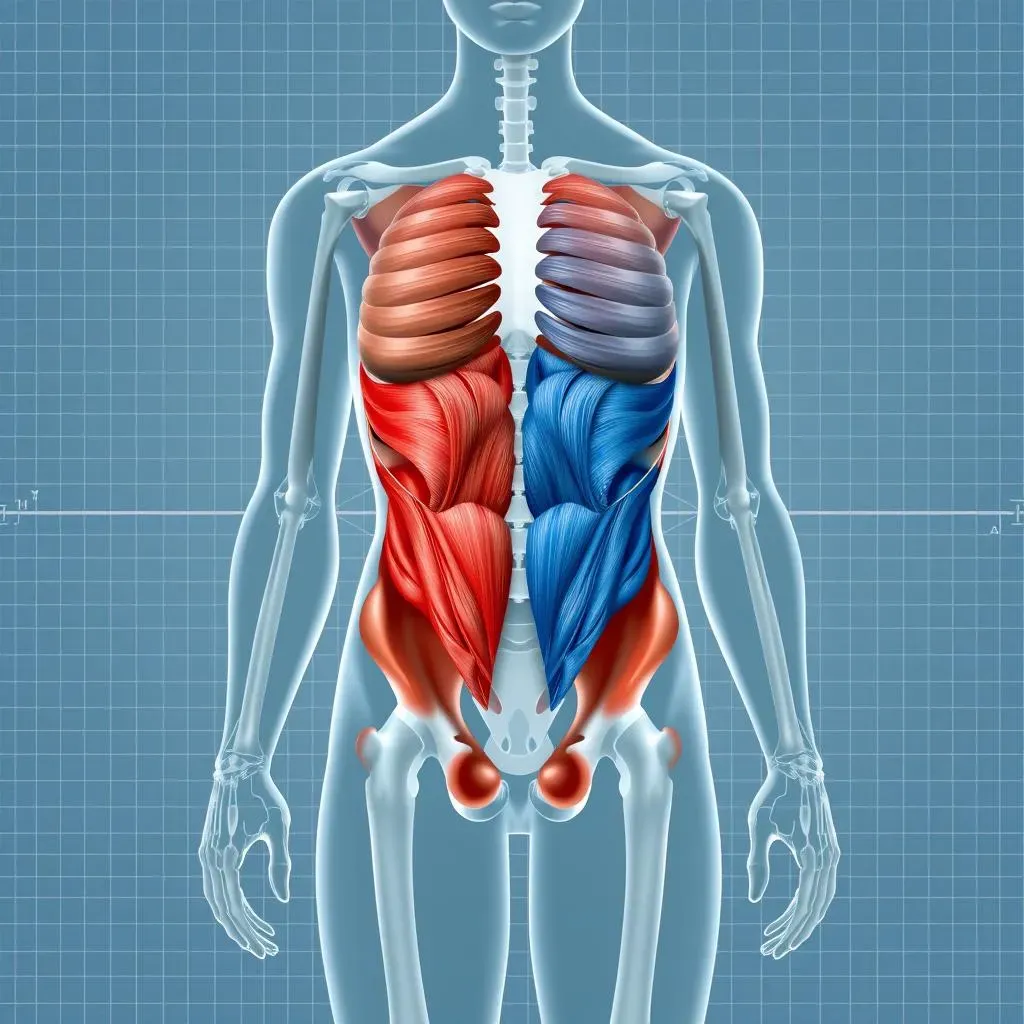Table of Contents
Forget endless crunches and sit-ups! If you're after a core that's not just for show but built for serious strength and stability, it's time to grab a kettlebell. This kettlebell workout for core is designed to revolutionize how you think about core training, moving beyond basic movements to engage your entire midsection in ways you never thought possible.
Understanding Your Core: More Than Just Abs

Understanding Your Core: More Than Just Abs
Alright, let's ditch the six-pack obsession for a minute and talk about what your core really is. It's not just those rectus abdominis muscles that pop when you flex. Your core is a complex network of muscles that wrap around your entire midsection, from your ribs to your pelvis. Think of it as your body's natural weightlifting belt, crucial for everything from standing upright to crushing your deadlift PR.
We're talking about the deep-lying transverse abdominis (TVA), your internal corset that stabilizes your spine. Then there are the obliques, responsible for twisting and bending. And don't forget the often-overlooked muscles of your lower back, the erector spinae, which work tirelessly to keep you upright. Even your hip flexors play a role in core stability and movement. It's a team effort, people!
Think of your core like the foundation of a building. A strong foundation supports the entire structure, allowing it to withstand stress and pressure. Similarly, a strong core supports your spine, protects your internal organs, and enables efficient movement. Neglecting your core is like building a skyscraper on a shaky base – it might look impressive at first, but it's only a matter of time before things start to crumble.
10 Killer Kettlebell Exercises for a RockSolid Core

10 Killer Kettlebell Exercises for a RockSolid Core
The Turkish Get-Up: Your New Core BFF
Alright, let's kick things off with the king (or queen!) of all kettlebell exercises: the Turkish Get-Up (TGU). Seriously, if you could only do one kettlebell exercise for your core, this would be it. It's a total-body movement that demands stability, coordination, and serious core engagement from start to finish. Don't be intimidated – break it down into manageable steps, and you'll be surprised at how quickly you progress.
The TGU isn't just about strength; it's about control. As you move through each transition – from lying down to standing up with the kettlebell overhead – your core has to work overtime to keep you stable and prevent you from toppling over. It's like a moving plank that challenges your core in all three planes of motion. Trust me; your abs will be screaming (in a good way!) after just a few reps.
Now, I know the TGU can look a little intimidating at first, but trust me, it's worth the effort. Think of it as a puzzle – each step builds upon the previous one, and once you've mastered the sequence, you'll feel like a total badass. Plus, it's a fantastic way to improve your shoulder stability and overall body awareness. Ready to give it a try?
The Double Kettlebell Squat: Core Strength on Overload
Next up, we have the double kettlebell squat. Now, you might be thinking, "Squats? Those are for legs!" And you're right, they are. But holding a kettlebell in each hand in the front rack position dramatically increases the demand on your core. Your core has to work overtime to maintain an upright posture and prevent you from collapsing forward under the weight.
This exercise is fantastic for building overall strength and stability, but it's especially effective for targeting the anterior core – those muscles on the front of your torso that are responsible for preventing extension. By loading the weight in front of your body, you force your core to work harder to resist the pull of gravity. The result? A stronger, more resilient core that can handle anything you throw at it.
Why Kettlebells Trump Traditional Core Workouts

Why Kettlebells Trump Traditional Core Workouts
so you might be wondering, "Why kettlebells? What's so special about them compared to regular core exercises like planks or crunches?" Well, my friend, kettlebells bring a whole new dimension to core training, thanks to their unique design and the dynamic movements they encourage. Unlike static exercises that isolate specific muscles, kettlebell exercises force your core to work as a stabilizer and power generator in three-dimensional space. It's like upgrading from a tricycle to a sports car – both will get you from point A to point B, but one is way more fun and effective!
Think about it: with a plank, you're essentially holding a rigid position. That's great for building isometric strength, but it doesn't translate as well to real-world movements. Kettlebell exercises, on the other hand, involve constant shifts in weight and momentum, which challenge your core in ways that planks and crunches simply can't. You're not just building strength; you're building functional strength that you can use in everything from lifting groceries to playing sports.
Plus, let's be honest, kettlebell workouts are way more engaging than endlessly repeating crunches. The variety of movements and the challenge of mastering new skills keep things interesting and prevent boredom from setting in. And when you're having fun, you're more likely to stick with it, right?
Unlocking the Benefits: Kettlebell Core Training for Performance

Unlocking the Benefits: Kettlebell Core Training for Performance
Rock-Solid Core, Rock-Solid Lifts
let's get down to brass tacks: why should you bother with kettlebell core training? Sure, a sculpted six-pack is nice, but the real benefits go way beyond aesthetics. A strong, stable core is the foundation for everything you do in the gym and in life. Think about it – every time you lift a weight, run, jump, or even just stand up straight, your core is working to stabilize your spine and transfer power. Kettlebell core training directly translates to improved performance in your bigger lifts, like squats, deadlifts, and overhead presses.
When your core is weak, it's like trying to fire a cannon from a canoe – you're going to lose a lot of power and stability. But when your core is strong, it's like having a solid platform from which to launch that cannon. You'll be able to generate more force, maintain better form, and reduce your risk of injury. It's a win-win-win!
Stability is the Name of the Game
One of the biggest benefits of kettlebell core training is improved stability. Kettlebell exercises, with their off-center weight and dynamic movements, force your core to constantly adjust and stabilize. This is especially important for preventing injuries, both in the gym and in everyday life. Think about all the times you have to twist, bend, and lift awkward objects – a strong, stable core will help you do it safely and efficiently.
Moreover, that improved stability also has a direct impact on your athletic performance. Whether you're a runner, a weightlifter, or a weekend warrior, a stable core will allow you to generate more power and move with greater efficiency. You'll be able to run faster, jump higher, and lift heavier – all while reducing your risk of injury. It's like having a secret weapon that gives you an edge over the competition.
- Improved Balance
- Reduced Risk of Falls
- Enhanced Athletic Performance
Beyond the Gym: Real-World Core Strength
Let's not forget about the benefits that extend beyond the gym walls. Kettlebell core training can have a profound impact on your everyday life. A strong core improves your posture, reduces back pain, and makes everyday movements like bending, lifting, and twisting easier and more comfortable. You'll find yourself moving with greater ease and confidence, whether you're carrying groceries, playing with your kids, or simply walking down the street.
So, if you're looking for a way to improve your overall health, fitness, and quality of life, look no further than kettlebell core training. It's a challenging but rewarding way to build a strong, stable core that will support you in everything you do. Get ready to unlock your full potential and experience the transformative power of a truly functional core!
Benefit | Description |
|---|---|
Improved Posture | Stronger core muscles help maintain proper spinal alignment. |
Reduced Back Pain | A stable core supports the spine and reduces stress on the back muscles. |
Easier Everyday Movements | Simple tasks become easier with a strong and functional core. |
Sample Kettlebell Circuit for a Stronger Core

Sample Kettlebell Circuit for a Stronger Core
Warm-Up: Prime Your Core
Before we dive into the circuit, let's get your body prepped and ready to roll. A dynamic warm-up is crucial for increasing blood flow, improving mobility, and activating your core muscles. Don't skip this step – it's like foreplay for your workout!
Start with 5-10 minutes of light cardio, such as jogging in place or jumping jacks. Then, move on to some dynamic stretches like arm circles, leg swings, and torso twists. Finish with a few rounds of bodyweight core exercises, such as planks, bird dogs, and glute bridges. This will prime your core for the work ahead and help prevent injuries.
- Cardio: 5-10 minutes (jogging, jumping jacks)
- Dynamic Stretches: Arm circles, leg swings, torso twists (10-15 reps each)
- Core Activation: Planks (30 seconds), bird dogs (10 reps per side), glute bridges (15 reps)
The Circuit: Crush Your Core
Alright, it's time to get down to business! This circuit is designed to challenge your core from all angles, building strength, stability, and endurance. Perform each exercise for the prescribed number of reps or time, then move immediately to the next exercise. Once you've completed all exercises, rest for 60-90 seconds, then repeat the circuit for a total of 3-4 rounds.
Remember to focus on proper form and control throughout each exercise. It's better to do fewer reps with good form than to crank out sloppy reps that could lead to injury. And don't be afraid to modify the exercises to fit your fitness level. If an exercise is too challenging, reduce the weight or shorten the duration. The goal is to challenge yourself, not to kill yourself!
Exercise | Reps/Time | Rest |
|---|---|---|
Kettlebell Turkish Get-Up | 1-2 reps per side | - |
Double Kettlebell Squat | 8-12 reps | - |
Single-Arm Kettlebell Swing | 10-15 reps per side | - |
Kettlebell Windmill | 5-8 reps per side | - |
Single-Arm Kettlebell Suitcase Carry | 30 seconds per side | 60-90 seconds |
Cool-Down: Show Your Core Some Love
You crushed it! Now it's time to cool down and help your body recover. A proper cool-down will reduce muscle soreness, improve flexibility, and promote relaxation. Don't skip this step – it's like giving your core a well-deserved hug after a tough workout.
Start with 5-10 minutes of light cardio, such as walking or stretching. Then, focus on static stretches that target your core muscles, such as cat-cow pose, child's pose, and side bends. Hold each stretch for 20-30 seconds, and breathe deeply. This will help your muscles relax and recover, so you can come back stronger for your next workout.
Forge Your Strongest Core Yet: The Kettlebell Advantage
Integrating kettlebell exercises into your core routine isn't just a trend; it's a transformative approach to building functional strength, stability, and a resilient midsection. By moving beyond traditional exercises and embracing the dynamic, off-center nature of kettlebell training, you unlock a new level of core engagement that translates to improved performance in all aspects of your life. So, pick up that kettlebell, challenge yourself with these exercises, and witness the power of a truly strong core. Your body will thank you for it.